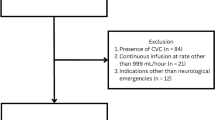Abstract
Recently, a controversy has arisen as to whether air or saline should be recommended for the correct localization of the epidural space with the loss of resistance technique. I report a case of a previously healthy parturient who developed pneumocephalus and severe headache following the use of the loss of resistance to air (LORA) technique to identify the epidural space. This case report raises one more time the question about the safety of the LORA technique for labor analgesia.
Zusammenfassung
In jüngerer Zeit wird kontrovers diskutiert, ob zur erfolgreichen Lokalisierung des Epiduralraumes mit der "Loss-of-resistance-Technik" als geeignetes Medium Luft oder Kochsalzlösung empfohlen werden soll. Es wird über den Fall einer vorher gesund gebärenden Patientin berichtet, die nach Anwendung der "Loss-of-resistance-to-air-Technik" (LORA) einen Pneumatozephalus und schwere Kopfschmerzen entwickelte. Dieser Fallbericht stellt noch einmal die Sicherheit des LORA-Verfahrens für die Analgesie zur Geburtshilfe in Frage.

Similar content being viewed by others
References
Aida S, Taga K, Yamakura T et al. (1998) Headache after attempted epidural block: the role of intrathecal air. Anesthesiology 88:76–81
Ash KM, Cannon JE, Biehl DR (1991) Pneumocephalus following attempted epidural anesthesia. Can J Anaesth 38:772–774
Avellanal M, Olmedilla L, Ojea R et al. (1996) Pneumocephalus after spinal anesthesia. Anesthesiology 85:423–425
Boezaart AP, Levendinng BJ (1989) Epidural air-filled bubbles and unblocked segments. Can J Anaesth 36:603–604
Gonzalez-Carasco FJ, Aquilar JL, Llubia C et al. (1993) Pneumocephalus after accidental dural puncture during epidural anesthesia. Reg Anesth 18:193–195
Katz Y, Markovits R, Rosenberg B (1990) Pneumocephalus after inadvertent intrathecal air injection during epidural block. Anesthesiology 73:1277–1279
Laviola S, Kirvela M, Spoto MR et al. (1999) Pneumocephalus with intense headache and unilateral pupillary dilatation after accidental dural puncture during epidural anesthesia for cesarean section. Anesth Analg 88:582–583
Mateo E, Lopez-Alacron D, Moliner S et al. (1999) Epidural and subarachnoid pneumocephalus after epidural technique. Eur J Anaesthesiol 16:413–417
Nay PG, Milaszkiewicz R, Jothilingam S (1993) Extradural air as a cause of paraplegia following lumbar analgesia. Anaesthesia 48:402–404
Robbins PM, Train JJA (1995) Pneumocephalus: an unusual complication of resuscitation. Anaesth Intensive Care 23:747–749
Saberski LR, Kondamuri S, Osinubi OY (1997) Identification of the epidural space: is the loss of resistance to air a safe technique? A review of the complications related to the use of air. Reg Anesth 22:3–15
Sethna NF, Berde CB (1993) Venous air embolism during identification of the epidural space in children. Anesth Analg 76:925–927
Sherer DM, Onyeije CI, Yun E (1999) Pneumocephalus following inadvertent intrathecal puncture during epidural anesthesia: a case report and review of the literature. J Matern Fetal Med 8:138–140
Stride PC, Cooper GM (1993) Dural taps revisited: a 20-year survey from Birmingham Maternity Hospital. Anaesthesia 48:247–255
Valentine SJ, Jarvis AP, Shutt LE (1991) Comparative study of the effects of air or saline to identify the extradural space. Br J Anaesth 66:224–227
Yentis SM (1997) Time to abandon loss of resistance to air. Anaesthesia 52:184
Author information
Authors and Affiliations
Corresponding author
Rights and permissions
About this article
Cite this article
Kuczkowski, K.M. Post-dural puncture headache, intracranial air and obstetric anesthesia. Anaesthesist 52, 798–800 (2003). https://doi.org/10.1007/s00101-003-0527-6
Issue Date:
DOI: https://doi.org/10.1007/s00101-003-0527-6
Keywords
- Post-dural puncture headache
- Pneumocephalus
- Epidural analgesia
- Dural puncture
- Loss of resistance technique
- Air
- Saline




